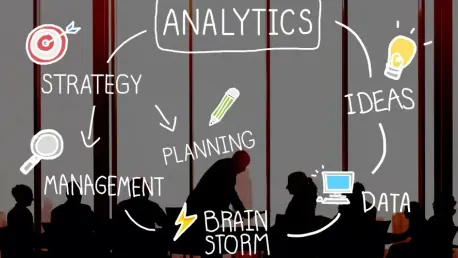In today’s fast-paced business environment, relying solely on analytics experts to generate timely reports and insights is no longer a sustainable approach. Business professionals across various industries now require immediate access to integrated analytics tools that allow them to draw actionable insights from complex data sets. The emergence of self-service analytics has addressed this growing necessity, empowering users to handle data independently and reducing dependence on continuous support from data professionals. This shift not only accelerates decision-making processes but also fosters a culture of data-driven thinking within organizations, improving responsiveness and adaptability in dynamic markets.
The Rising Demand for Self-Service Analytics
The demand for self-service analytics is rapidly growing as professionals increasingly seek to make data-driven decisions without the delays associated with waiting for specialized analytics experts. This shift is primarily driven by the necessity for immediate access to data and the ability to generate insights swiftly. Self-service analytics tools empower users to explore data, create reports, and visualize information autonomously, thereby promoting a culture of data-driven decision-making within organizations.
Designed to be user-friendly, self-service analytics tools enable business professionals to perform complex data analysis without extensive technical expertise. Features like intuitive interfaces, drag-and-drop functionalities, and pre-built templates make it easier for users to interact with data. By democratizing access to analytics, organizations can leverage the collective intelligence of their workforce, leading to more informed and timely decisions. This not only optimizes operational efficiency but also enhances an organization’s ability to swiftly respond to market changes and emerging trends.
The capability to independently navigate and analyze data fosters innovation and agility within teams. As more professionals gain proficiency with these tools, they contribute diverse perspectives and insights that can drive business growth and improvement. This empowers organizations to harness the full potential of their data resources, transforming raw data into valuable, actionable information. Consequently, self-service analytics not only addresses the immediate need for quick insights but also establishes a foundation for a more intelligent and dynamic business environment.
Embedded Analytics Tools
Embedded analytics tools seamlessly integrate with everyday applications, significantly enhancing the user experience by eliminating the need to switch between multiple programs. By incorporating analytics directly into workflows, these tools maintain user engagement and provide real-time analysis and visualization capabilities. This integration ensures that users can access relevant data and insights within the context of their work, leading to more efficient and effective decision-making processes.
Advanced embedded analytics tools leverage AI and machine learning to automate critical workflows, improve productivity, and initiate essential actions. These tools can analyze extensive data volumes in real-time, identify patterns, and provide predictive insights that are invaluable for strategic planning. By embedding analytics into business applications, organizations can streamline processes, reduce manual effort, and achieve better outcomes. The integration of predictive analytics within applications enables companies to anticipate trends and adjust strategies proactively, ensuring a competitive edge in the marketplace.
Moreover, embedded analytics contribute to developing a data-centric culture within organizations. As data-driven insights become an integral part of daily operations, employees across various departments can make more informed decisions that align with overall business objectives. This visibility and accessibility to real-time data foster a collaborative environment where insights are shared and utilized efficiently, driving organizational success. By embedding analytics directly into existing business tools, companies enhance their ability to react to real-time information and pivot strategies accordingly, optimizing performance and achieving long-term goals.
Accelerating Insights with Integrated Capabilities
Embedded analytics play a crucial role in driving business results by providing in-context analytics. This approach allows business users to leverage analytics capabilities within their immediate work environment, resulting in quicker, data-driven decisions. By integrating analytics into existing workflows, organizations can eliminate delays traditionally associated with data processing and report generation.
Integrated analytics capabilities enable users to access and analyze data from multiple sources, providing a holistic view of business performance. These tools often feature advanced data blending, visualization, and interactive dashboards, allowing users to explore data from various perspectives. By accelerating insights, organizations can respond to market changes more effectively and stay ahead of the competition. The ability to rapidly visualize and interpret data ensures that strategic decisions are grounded in accurate, comprehensive information.
The seamless integration of analytics within business processes not only enhances efficiency but also drives innovation. Employees equipped with powerful, contextually relevant insights are better positioned to propose and implement solutions that address emerging challenges and opportunities. This agility is especially crucial in dynamic industries where quick adaptation can mean the difference between success and failure. Integrated analytics tools also facilitate continuous improvement by enabling ongoing assessment of performance metrics and prompt adjustments to strategies based on real-time data.
Evolution and Types of Analytics
The evolution of analytics from descriptive to predictive marks a significant advancement in the field, offering deeper insights and foresights into business operations. Descriptive analytics have traditionally provided snapshots of past and present performance, helping organizations understand historical trends and outcomes. However, the growing volume and complexity of data require more sophisticated analytics techniques to derive meaningful insights and inform future strategies.
Diagnostic analytics enable business users to independently delve deeper into data, employing embedded AI to uncover hidden relationships and identify potential risks or compliance gaps. These tools empower users to investigate the root causes of issues and make data-driven decisions to address them. By leveraging diagnostic analytics, organizations can gain a more profound understanding of their operations, optimizing processes, and improving overall performance. This deeper level of analysis aids in pinpointing areas for improvement and refining operational strategies.
Predictive analytics, which forecasts future outcomes based on current data, is increasingly gaining traction across various industries. Predictive tools allow users to run what-if scenarios, enabling them to refine strategies and minimize risks by anticipating potential future events and outcomes. Areas such as marketing, credit scoring, and crime prevention particularly benefit from predictive analytics, where forecasting future trends and behaviors can drive better operational and strategic decisions. These analytics tools often employ advanced algorithms and machine learning techniques to offer precise predictions, helping organizations navigate uncertainties and capitalize on emerging opportunities.
Predictive Analytics and its Applications
Predictive analytics is proving to be a game-changer, as its ability to foresee future outcomes based on existing data is becoming vital across a range of industries. These tools enable users to perform what-if analyses, refine strategies, and mitigate risks by anticipating future scenarios. Marketing, credit scoring, and crime prevention are notable sectors where predictive analytics has shown significant effectiveness. By leveraging predictive insights, organizations can proactively address potential challenges and seize new opportunities, thereby making strategic decisions that drive better outcomes.
Customized predictive analytics tools are often tailored to meet specific business needs, using advanced algorithms and machine learning techniques to analyze historical data and predict future events. These sophisticated tools offer a competitive advantage by enabling organizations to remain agile and responsive in fast-paced environments. Incorporating predictive analytics into decision-making processes allows businesses to anticipate changes, adapt strategies preemptively, and maintain a proactive stance in the market. This proactive approach to data utilization not only enhances operational efficiency but also positions organizations to lead in innovation and development.
The implementation of predictive analytics extends beyond simple forecasting. It enables businesses to optimize resources, improve customer experiences, and enhance risk management practices. By understanding and anticipating customer behaviors, companies can tailor their offerings to better meet market demands and optimize their marketing strategies. In finance, predictive analytics can improve credit scoring accuracy, reducing default rates and enhancing portfolio quality. Crime prevention efforts benefit from predictive models that help allocate resources more effectively and prevent incidents before they occur. The diverse applications of predictive analytics underscore its value as a transformative tool that drives smarter, data-driven decisions across industries.
Innovations and Market Disruption
The advanced capabilities of AI, such as forecasting, self-regulation, and dynamic adjustment, are rapidly transitioning from futuristic concepts to mainstream business applications. These cutting-edge analytics tools are enabling businesses to disrupt existing markets and create new ones by providing unparalleled insights and operational efficiencies. For instance, ride-hailing apps exemplify market disruption by leveraging AI to balance demand and supply dynamically, offering a seamless user experience and fundamentally transforming the transportation industry.
Innovations in analytics are driving market disruption by allowing organizations to operate more efficiently and effectively. These advanced tools can automate routine tasks, optimize resource allocation, and provide real-time insights that enhance decision-making processes. By embracing sophisticated analytics, businesses gain a competitive edge and drive innovation within their respective industries. The utilization of AI for dynamic adjustments ensures that companies can adapt to fluctuating market conditions swiftly, maintaining their relevance and competitiveness.
Beyond operational improvements, the transformative potential of AI-driven analytics extends to strategic planning and market differentiation. Companies that harness these advanced tools can identify new business opportunities, optimize product development cycles, and enhance customer engagement strategies. The ability to leverage real-time data for proactive decision-making allows businesses to stay ahead of market trends and respond to shifts with agility and precision. As AI continues to evolve, its integration into analytics will likely lead to even more profound market disruptions, opening new avenues for growth and innovation.
Strategic Implementation and Vendor Considerations
In today’s rapidly evolving business landscape, relying exclusively on analytics experts for timely reporting and insights is no longer viable. Professionals across various industries now need instant access to advanced analytics tools that allow them to derive actionable insights from complex data sets on their own. The advent of self-service analytics has effectively addressed this critical need, empowering users to manage and analyze data independently, which reduces the reliance on continuous support from data specialists. This transition not only speeds up the decision-making process but also nurtures a culture of data-driven thinking within organizations. As a result, businesses become more responsive and adaptable, gaining an edge in dynamic and competitive markets. By fostering self-reliance in data analysis, companies are better positioned to implement swift strategies based on real-time insights, ensuring sustained growth and efficiency in today’s fast-paced environment.









